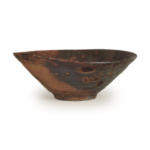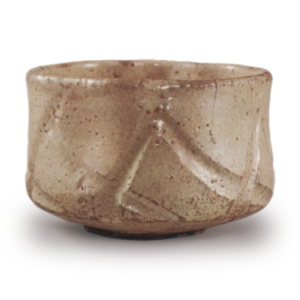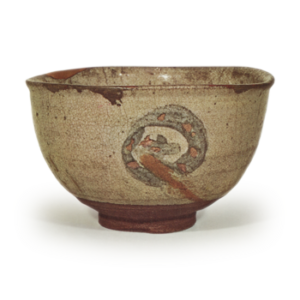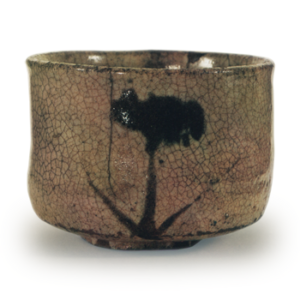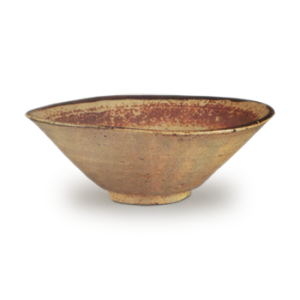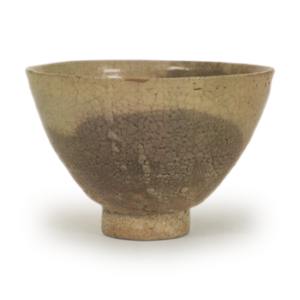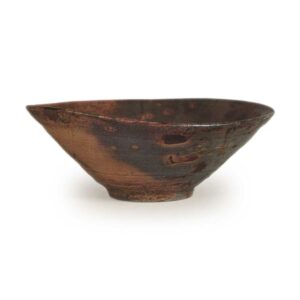
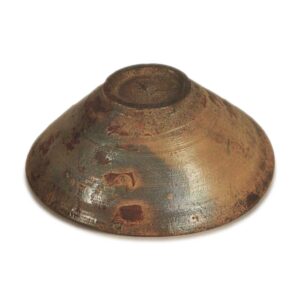
Name: Akikusa
Height: 4.7 – 5.5 cm
Diameter: 13.7 – 14.3 cm
Height of foot ring: 4.7 – 4.8 cm
Height of rim: 0.5 cm
The name “Ichihara” is thought to have been given by Masuda Dono in reference to Ichihara Village in Kuramaguchi, Kyoto, which was famous for its autumn flowers in the olden days, as the original name of this teacup was “Akikusa”.
Like the Hiroshima teacup, this is a single-handled teacup, but its shape is different from the Hiroshima teacup, with a slightly low foot that tapers to a small, tight shape, and the body opening almost straight from the foot to form a so-called morning glory shape, and the overall shape being slightly distorted to form a woven hat shape, making this a teacup with a shape and appearance that is even more deeply imbued with a wabi aesthetic.
The small, compact foot is very simply carved, and the center of the foot is slightly raised, with small cracks in the surface of the clay. The rim is shallowly scraped, and the open-work marks on the outside of the rim are finely and evenly distributed, giving the bowl a lively and nimble appearance.
The inside of the bowl is also finely textured, with the lines of the potter’s wheel clearly visible in the tea pool, giving the inside of the bowl a tight, compact shape.
Although this small, flat tea bowl has a very neat and tidy appearance, the highlight of this tea bowl is the richness of the glaze, rather than the shape. The outside is almost completely divided into blue and red sections, and within the blue sections, there are several areas where the glaze has flaked off to reveal the underlying brownish-red clay, and the blue glaze is applied in varying thicknesses, with the thick sections appearing blue-grey and the thin sections slightly yellowish.
The reddish areas are more yellowish than reddish, and in some places where the glaze is thin, the iron in the clay shows through, appearing brownish. Moreover, there are also variations in the yellowishness, and it is not uniform.
The inside of the bowl is even more detailed. Two-thirds of the inside is blue, with only a small amount of red. The bluish-gray areas have a greenish or yellowish tinge, and there are small and large spots of bubbling. As with most toto, the glaze is thin and well-dissolved, giving it a glossy surface, but this tea bowl in particular has a particularly strong sheen. The triangular crack from the rim to the body is truly pitiful, and there is also a gold repair on the rim and a scratch on the mountain.
According to the Taisho Meiki Kan (A Guide to Famous Tea Utensils from the Taisho Period), the box is described as “Paulownia-lacquered with paper pasted on”, and the box that is now the outer box is included as an attachment, but there is now an inner box made of paulownia wood, and on the front of the lid is written in India ink “Totoya Ichihara”, and the writer is Masuda Don’o. It is thought that this inner box was written on when it was in the Masuda family. On the paper attached to the outer box, there are the words “Uoya Akikusa Chawan”, and next to that, in red, the words “From the Soya family” can be read, but it is unclear.
It is said that it was formerly owned by the Himeji Sakai family and was in the possession of Sakai Munemasa, who was highly regarded as a tea master at the end of the Edo period. According to a note written by Masuda Don’o that is attached to the tea bowl, the history of its ownership is as follows: “At first it was in the hands of Daizen (a dealer in tea utensils), then it was owned by Yamazumi, and then it was passed on to Negishi (Negishi ) and was passed on to Negishi through a bidding process, etc.” This shows that it came into the possession of his brother, Katsunori Masuda, in February 1904.

